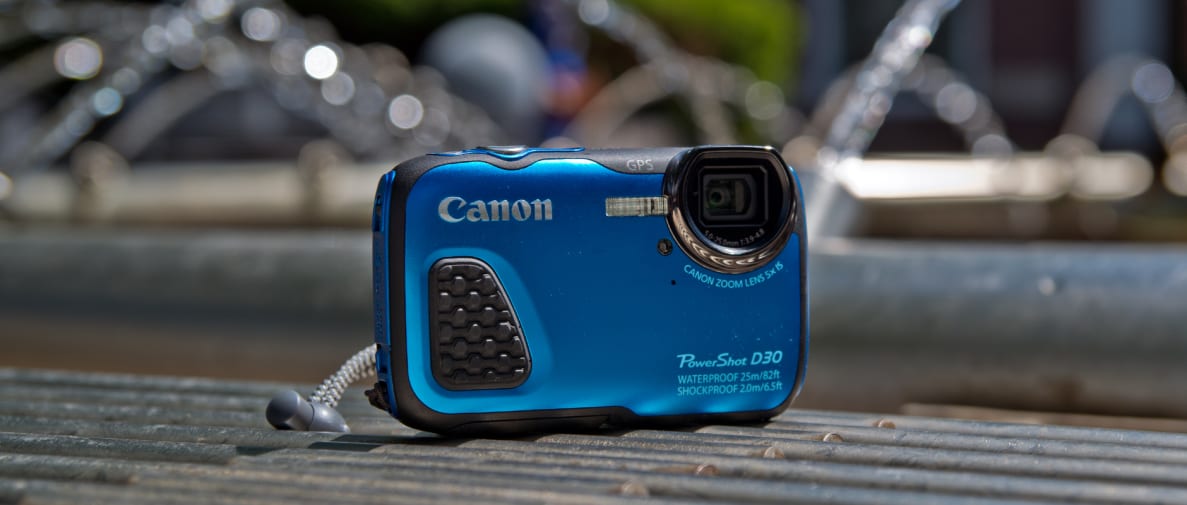Pros
Cons
Maybe you're heading to the beach, going scuba diving, or simply handing the camera off to the kids while on family vacation. For instances like these, a toughcam is the way to go. These cameras are built to survive short drops, long dives underwater, and all the abuse that a child can inflict on an electronic device. While we've already checked out Nikon's newest toughcam entry, Canon has also updated its lineup with the new Canon PowerShot D30 (MSRP $329.99).
The D30 replaces the D20 (released back in 2012), bringing with it enhanced survival skills an a new physical design. This new camera can survive treks underwater as deep as 82 feet and drops of up to 6.5 feet—more than enough to get through casual use. Other than that, however, it doesn't do much to change up the D20's formula. With the waterproof camera market as competitive as ever, is it worth paying full price for yesterday's tech?
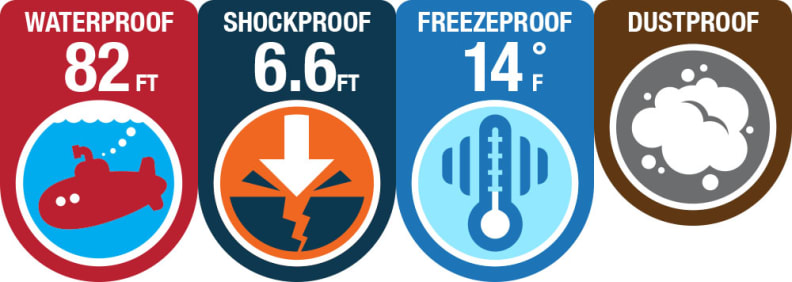
Design & Handling
It certainly looks like a toughcam
Though point and shoots are hardly flying off the shelves these days, it's always a little disappointing when we see an updated model bearing the same exact hardware as its predecessor. That's exactly what Canon did with the D30—looking at the spec sheets of both this camera and the one it replaces, the D20, you'll see a lot of similarities.
The chassis is a lot different however. A refreshingly improved outer grip and less radical design means a camera that isn't going to squirt out of your hands at the first sign of moisture. A beefier hand strap and more substantial controls also add a reassuring chunkiness to the camera. If there's one hallmark to the D30's design, it's keeping things basic, but functional.
{{ photo_gallery "tour" }}
On the back of the camera is a 461k-dot LCD, flanked by some very thick controls. The buttons are big and easy to use, but the waterproofing lends them a gummy feeling. Otherwise the control cluster is basically the same as Canon's cheaper point and shoots. On the bottom of the camera, a sealed battery door protects the SD/SDHC/SDXC card slot and the NB-6L rechargeable lithium-ion battery. Protecting a miniHDMI port, USB, and DC-in ports is yet another sealed door, this time on the side of the camera.
Once you get past the outer design and the waterproofing, the D30 is basically the same as the existing D20. The D30—like the D20—has a 1/2.3" 12.1 megapixel sensor behind a still-mediocre f/3.9-4.8 5x zoom lens (5-25mm). Having two years to catch up to offerings like the Olympus TG-2, Pentax WG-3, and the latest refresh to Nikon's waterproof toughcam, it's a bit odd that the D30 has such a narrow aperture when most of its other competitors have f/2.8 or wider.
{{ photo_gallery "design" }}
The main issue with the Canon's lens is that it doesn't open as wide as the competition, letting in less light. This means that it has to rely on upping its sensitivity in low light, giving you the same grainy, blurry photos you get from your smartphone. The D30 may be able to survive dips down the 82 feet, but you'll need to bring a lot of extra light if you expect to take photos at that depth.
Features
One-trick pony
Much of the appeal for buying Canon's PowerShot D30 lies in its rugged exterior. Like other toughcams on the market, the main draw is that it can go places even high-end DSLRs can't go without investing in super-expensive waterproof housings. Even then, carrying all that equipment won't be fun when you're trying to travel light. Though Nikon's 1 AW1 is a good compromise if you want interchangeable lenses and underwater shooting, tough point-and-shoots like the D30 are simply more portable.
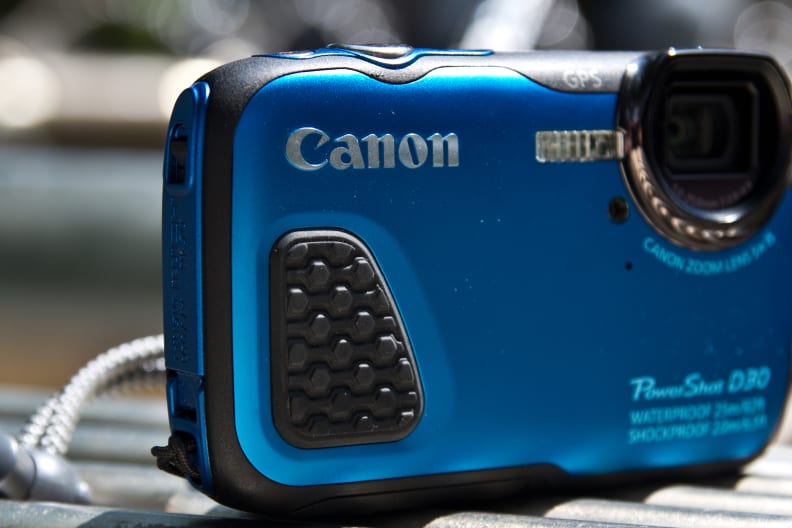
A re-designed front grip makes the D30 much easier to hold underwater.
If you're looking to shoot some video, the D30 offers the ability to shoot in full HD, but audio will sound strange with its linear PCM mono audio recording—only one channel will be recorded. The option exists to shoot in .mov or AVCHD video, in resolutions of 1080p, 720p, and 640p. Should you like the included filters in the Auto mode, you can use them in your videos—but definitely remember to change your settings if you don't want all your videos to have the last filter you used.
Beyond that, though, this is a very basic camera. Though it has a GPS antenna to add location data to your images, it's not as fleshed-out or useful as the maps and points of interest you can access on the Nikon AW120. Additionally, the D30 lacks wireless sharing—over WiFi or any other standard. If you want to share your snaps online while on the go you'd better have a laptop and a wireless card handy.
The D30 does include an HDMI port for sharing photos when hooked up to a television, but practically every one of its competitors has the same functionality. It offers far less in the way of sharing with mobile devices and in this day and age, that's a non-starter for the Facebook and Instagram crowd.
Performance
Despite its tough exterior, inside it's all point and shoot.
Once we took the D30 for a spin in our labs, we found a camera that performs well for a point-and-shoot but fails when compared to its more advanced tough peers. And if you're ignoring the durability and just comparing the D30 on price alone, it really falls behind contemporaries like the Sony HX50V. Even Canon's PowerShot 340 HS handily outpaces this updated camera. It may cost $350, but it performs like a camera that costs about half as much.
{{ photo_gallery "sample-photos" }}
That said, the D30 isn't all that bad. Despite relatively low sharpness and high noise, the camera does keep its color reproduction in check. However, that sharpness loss is severe enough to really set it back. Subjects in the very middle of the frame look okay, but the corners are soft and image quality leaves a lot to be desired.
Of course, if you're looking at this part of the market you're probably willing to sacrifice a bit of image quality for durability. And for most casual applications the D30's shots will be fine. But the D20 wasn't the best camera when it was released in 2012 and two years of advances in this part of the market haven't done the D30 any favors. If Canon had included its newest Digic 6 processor in the D30 things might have been improved, but relying on the same Digic 4 as the D20 just feels like Canon is mailing it in.

Fine detail is tossed out with the default noise reduction.
Video suffers from the same sharpness issues as still shots do, making for iffy quality. Though the videos are captured in full HD, we're seeing the same issues now that we saw in 2012 with the D20. You can expect things like strobing and blurring to show up in most settings, and if objects are moving at more than a snail's pace video quality is smartphone-quality at best. In low light, focusing problems and severe noise issues only make things worse.
Conclusion
Like the famous 80's toy, skip it.
Though point and shoots are a dying breed, the one thing rugged cameras offer over smartphone cameras is the ability to go places a phone can't. Though there's only a select few rugged point and shoots on the market, they bring a lot of useful features to those looking for a vacation camera that can withstand kids and adventures. Olympus, Panasonic, Pentax, and Nikon, in particular, have done a lot of work in the past two years to produce great point-and-shoots that happen to be durable, and not simply cheap point-and-shoots that won't keel over if they fall in the pool.
However, despite Canon's focus on updating the outside to improve the durability ratings, it didn't do much to make the guts of the D30 any better. The competing tough cams from Nikon, Pentax, and Olympus are simply better cameras. Worse, most of the competition costs the same or less than the D30. The D30 is easy to use, but it's tough to justify more money for a worse camera.
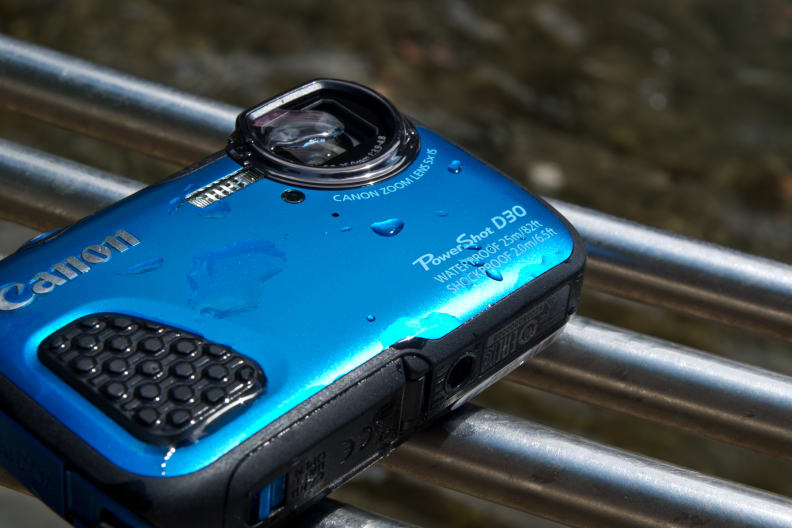
Big boasts are made on the front of the camera.
That's not to say that this camera is terrible—it's not—but you're paying a premium for the Canon name, and little else. If you're looking to save money, get a more feature-laden camera, or both, shopping around will almost assuredly land you a better piece of equipment. You could even pick up the D20 itself (where available) and get practically identical image quality for less money.
To wit, this year's Nikon AW120 ($349.95 MSRP) offers a wider aperture, GPS navigation, WiFi sharing, a metal exterior, better image quality, and remote shooting with Nikon's mobile app—for only $20 more. That should put things into perspective as to how much you're sacrificing when you buy the D30. Additionally, this year's Olympus TG-3 offers just about everything on that lists sans app— for the same amount of money as the D30. You may just be looking for a camera to fit the bill and not care about extras, but it's better to have tools and not use them than not have features and need them, right?
If you want to pay less for a comparable camera, you can always pick up one of last year's cameras at a deep discount. Panasonic's TS5, as well as the Pentax WG-3 are both below $300 online, and offer a bit more than the D30 brings to the table. For a full breakdown on 2013's best waterproof models, check out our waterproof roundup from last year. We'll have a 2014 version soon, but you can bet the D30 won't earn high marks. Though it's not exactly a tough sell when someone says an entry-level point and shoot is not that great, we still have to show our work. In spite of good color accuracy and decent white balance, this is one camera that doesn't cut it compared to the competition.
Color & White Balance
First with the good
Color accuracy on the D30 is actually pretty good. With a ∆C00 saturation error of 2.36, and a saturation of 103% when you turn the My Colors feature off, you can expect little visible fault with chroma error. You might find that pictures aren't as saturated as they might be on your smartphone, but there are plenty of options for punching up your shots with the My Colors modes.

Great color performance for a point and shoot. Little to take issue with here.
Using the other color options will shift colors a bit to make certain things stand out more than others. You can also mute colors, and take desaturated images. Though most experienced shooters would rather have the ability to shoot in RAW, there's not much that can be done when the camera can't do that.

Incandescent light gives an odd colorcast when you shoot in automatic white balance.
If you're bouncing in between the great outdoors, indoors, and even underwater, you're going to want to pay attention to what white balance you set. The automatic white balance is good for a point and shoot, but even the best cameras typically have a tough time getting the right color temperature. These problems are most magnified when you shoot in conditions lit by incandescent bulbs—but again, no surprises there.
Sharpness
Sharp as a spoon
Our resolution tests revealed a camera that simply doesn't hold up to the competition like it used to. Though the D30 isn't going to set any records with its tiny sensor and iffy 5x zoom lens, its performance here is troubling. Because the sensor is so small and the widest aperture at full telephoto is right up against the diffraction limit, there are sharpness tradeoffs that can't be avoided.
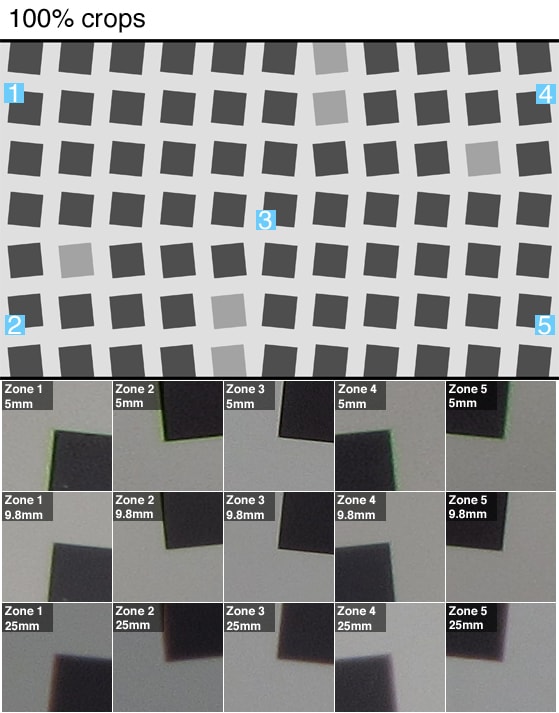
At full zoom, things get hairy.
As you can see from the 100% crops, at no focal length is the image all that impressive. Intense oversharpening and some chromatic aberration mar the images taken by the D30. You can see this in your shots in the form of some haloing (meant to make high-contrast edges more punchy), as well as some chromatic aberration on the outside of hard lines. You won't often see this without pixel-peeping, but it will rear its ugly head when you go to print out pictures from your vacation.
To its credit, the D30 doesn't distort your images in a measurable fashion. Ever see strange perspectives introduced by cameras that make the world look somewhat spherical? None of that is present on the images shot by the D30.
Noise
Turn down for what?
As it is with most point-and-shoots, lower light sensitivity means more noise. It's just a consequence of sensor technology being imperfect, and honestly you're going to find generally higher noise levels among all point-and-shoot cameras like the D30.

Fine detail is tossed out with the default noise reduction.
However, even among point and shoots, the D30 has high noise levels. The noise level passes 1% at ISO 200, and increases from there. While this is fairly pedestrian, it takes an aggressive noise-reduction algorithm to get that result—and that causes a lot of detail loss. Fine lines in the background of your shot important? Sorry. We weren't that dismayed by this result when we reviewed the D20 in 2012, but the competition is far better these days and the D30 doesn't measure up.
To keep noise as low as possible you can shoot in ISO 100 at all times, but you're going to see a lot of motion blur in your photos and low light shooting at that ISO is basically impossible. If you take your camera underwater, there won't be enough light to use this setting—so you will be forced to use a noisier ISO setting to get usable pictures.
Video
Let the water hold me down
Simply put: video quality is not great. Low sharpness, high noise, and detail loss ensure some less-than-stellar video quality, even at full HD. You should be aware that you need to shoot in lighting conditions above 12 lux to reach functional brightness levels, which we define as 50 IRE on a waveform monitor. That's not terrible, but anything dimmer than your average restaurant is going to give you trouble.
You'll see these issues come up in situations where there are lots of lines together moving fast, or if there's low light. Video may have been an afterthought here, but it's definitely not all that awe-inspiring.
In bright light, the D30 was able to maintain an lw/ph of 425 horizontally, and 375 vertically. That's bad by any measure. In low light, noise becomes more severe, and the measured lw/ph drops to 300 horizontal, and 325 vertical.
Meet the tester
A seasoned writer and professional photographer, Chris reviews cameras, headphones, smartphones, laptops, and lenses. Educated in Political Science and Linguistics, Chris can often be found building a robot army, snowboarding, or getting ink.
Checking our work.
Our team is here to help you buy the best stuff and love what you own. Our writers, editors, and experts obsess over the products we cover to make sure you're confident and satisfied. Have a different opinion about something we recommend? Email us and we'll compare notes.
Shoot us an email